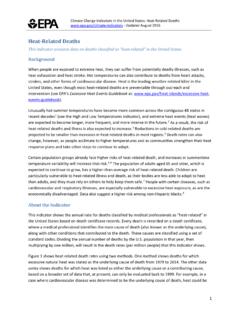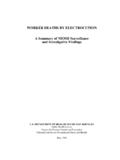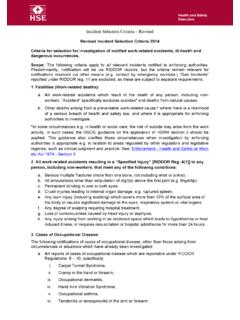Transcription of Health and Global Environmental Change SERIES, No. 2 Heat ...
1 Health and Global Environmental ChangeSERIES, No. 2 heat -waves:risks and responsesISBN 92 890 1094 0 Health and Global Environmental ChangeSERIES, No. 2 World Health OrganizationRegional Office for EuropeScherfigsvej 8, DK-2100 Copenhagen , DenmarkTel.: +45 39 17 17 17 Fax: +45 39 17 18 18E-mail: site: : risk and responsesHealth and Global Environmental ChangeSERIES, No. 2 heat -waves: risks and responsesLead authors:Christina Koppe,Sari Kovats,Gerd Jendritzky and Bettina MenneContributing authors:J rgen Baum ller,Arieh Bitan,Julio D az Jim nez,Kristie L. Ebi,George Havenith,C sar L pez Santiago,Paola Michelozzi,Fergus Nicol,Andreas Matzarakis,Glenn McGregor,Paulo Jorge Nogueira,Scott Sheridanand Tanja Wolf2 AbstractHigh air temperatures can affect human Health and lead to additional deaths even under current climatic conditions.
2 heat -waves occur infrequently in Europe and can significantly affect human Health , as witnessed in summer 2003. This reportreviews current knowledge about the effects of heat -waves, including the physiological aspects of heat illness andepidemiological studies on excess mortality, and makes recommendations for preventive action. Measures for reducing heat -related mortality and morbidity include heat Health warning systems and appropriate urban planning and housing heat Health warnings systems need to be implemented in European countries. This requires good coordinationbetween Health and meteorological agencies and the development of appropriate targeted advice and interventionmeasures.
3 More long-term planning is required to alter urban bioclimates and reduce urban heat islands in building design should keep indoor temperatures comfortable without using energy-intensive space heat -waves are likely to increase in frequency because of Global climate Change , the most effective interventions,measures and policies to protect the Health of vulnerable Europeans need to be developed and EFFECTSHEAT STROKE - prevention and controlRISK ASSESSMENTRISK MANAGEMENTINFORMATION SYSTEMSENVIRONMENTAL MONITORINGCITY PLANNINGText editing: David J BreuerDesign and layout: Emilio Dotto EDB&RDBC over design: Elis MartinelliPrinted by: ColomboAddress requests about publications of the WHO Regional Office to.
4 By e-mail Download this pubblication from (for copies of (for permission to reproduce (for permission to translate them) by postPublicationsWHO Regional Office for EuropeScherfigsvej 8DK-2100 Copenhagen , Denmark World Health Organization 2004 All rights Regional Office for Europe of the World Health Organization welcomes requests for permission toreproduce or translate its publications, in part or in designations employed and the presentation of the material in this publication do not imply the expression of anyopinion whatsoever on the part of the World Health Organization concerning the legal status of any country, territory, cityor area or of its authorities.))
5 Or concerning the delimitation of its frontiers or the designation country orarea appears in the headings of tables, it covers countries, territories, cities, or areas. Dotted lines on maps representapproximate border lines for which there may not yet be full mention of specific companies or of certain manufacturers products does not imply that they are endorsed orrecommended by the World Health Organization in preference to others of a similar nature that are not mentioned. Errorsand omissions excepted, the names of proprietary products are distinguished by initial capital World Health Organization does not warrant that the information contained in this publication is complete and correctand shall not be liable for any damages incurred as a result of its use.
6 The views expressed by authors or editors do notnecessarily represent the decisions or the stated policy of the World Health Change AND TEMPERATURE Observed changes in the frequency and intensity of heat -waves and future climate IMPACT OF heat ON HUMAN Physiological aspects of temperature Epidemiological studies of Health WARNING Methods used by heat Health warning heat stress Public Health Survey of heat Health warning systems in Case Research Current research into the development of heat Health warning Urban climates and urban heat Urban Urban planning, design and Indoor Potential impact of climate Change on urban Discussion and AND The research Public Health agencies and meteorological Long-term intervention strategies97 REFERENCES98 ANNEX 1.
7 Programme of the cCASHh Workshopon Vulnerability to Thermal Stresses, 5 7 May 2003, Freiburg, Germany112 ANNEX 2. Questionnaire on extreme thermal events and Health warning systems114 ANNEX 3. Current status of heat Health warning systems in Europe116 ANNEX 4. Projection of climate Change in European cities1184 ForewordThis important publication, reviewing the effects of heat stress on Health and potential strategies toreduce vulnerability to thermal stress, is the work of a strong collaborative team of investigators fromseveral European countries. It is particularly timely given the high-profile effects of the heat -wave inFrance in 2003 that have reinforced the need for societies to cope more effectively with ageing of the European population, together with the potential effects of climate Change , mayexacerbate the threats to human Health posed by thermal stress in the future.
8 heat - Health warningsystems offer the potential for collaboration between meteorological agencies and Health , merely issuing warnings is unlikely to substantially reduce heat -related deaths. Communityoutreach to vulnerable groups will be necessary, and the impact of such systems must be evaluated toensure that they deliver the promise of reducing heat -related challenge of reducing theeffects of thermal stress, especially on elderly people, also requires commitment from policy-makersand building designers to improve indoor environments without using approaches that lead toincreases in greenhouse gas emissions.
9 Health researchers and those studying the built environmentneed to collaborate to determine cost-effective designs to reduce thermal publication makes an important contribution to understanding of the effects of thermal stressand effective responses. It complements other work such as that on the Health effects of floods andthe effects of climate on infectious diseases that has been undertaken under the Climate Change andAdaptation Strategies for Human Health (cCASHh) contributors to this publication are tobe congratulated on marshalling existing evidence in an accessible form and indicating researchquestions that still need to be HainesDeanLondon School of Hygiene and Tropical Medicine United Kingdom5 ForewordWhen the Climate Change and Adaptation Strategies for Human Health (cCASHh)
10 Project started on 1 May 2001, few people would have thought that its results would be so heat -wave of August 2003 in Europe and its high toll of victims in various parts of Europe havemade it clear once again that no one on this planet will remain unaffected by the effects of climatechange. One heat -wave does not prove that the world is getting hotter, but last summer s weather fit aglobal trend that has seen previous records shattered with increasing thehistorical data for heat -waves may leave much to be desired, the August heat -wave in Europe hascertainly broken all records for heat -induced human publication summarizes the findings of work package 3 of the project Vulnerability Assessment ofthermal stresses.














